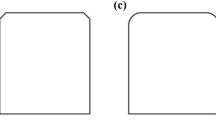Abstract
During ground faults on transmission lines, a number of towers near the fault are likely to acquire high potentials to ground. These tower voltages, if excessive, may present a hazard to humans and animals. This paper presents analytical methods in order to determine the transmission towers potentials during ground faults, for long and short lines. The author developed a global systematic approach to calculate these voltages, which are dependent of a number of factors. Some of the most important factors are: magnitudes of fault currents, fault location with respect to the line terminals, conductor arrangement on the tower and the location of the faulted phase, the ground resistance of the faulted tower, soil resistivity, number, material and size of ground wires. The effects of these factors on the faulted tower voltages have been also examined for different types of power lines.
Similar content being viewed by others
References
Carson, J.R., 1926. Wave propagation in overhead wires with ground return. Bell Syst. Technol., 1(5):539–554.
Dawalibi, F., Niles, G.B., 1984. Measurements and computations of fault current distribution on overhead transmission lines. IEEE Trans. on Power Apparatus and Systems, 103(3):553–560. [doi:10.1109/TPAS.1984.318744]
Edelmann, H., 1966. Electrical Calculus of Interconnected Networks. Publishing Technical House, Bucharest (in Romanian).
Endrenyi, J., 1967. Analysis of transmission tower potentials during ground faults. IEEE Trans. on Power Apparatus and Systems, 86(10):1274–1283. [doi:10.1109/TPAS.1967.291904]
Romanian Institute of Electrical Engineering Research and Development (ICEMENERG), 1993. Methodology of Current Fault Calculus in Electrical Networks. PE 134/1984. ICEMENERG, Bucharest (in Romanian).
Rudenberg, R., 1959. Transient Performance of Electric Power Systems. Publishing Technical House (Translated into Romanian).
Verma, R., Mukhedkar, D., 1979. Ground fault current distribution in sub-station, towers and ground wire. IEEE Trans. on Power Apparatus and Systems, 98(3):724–730. [doi:10.1109/TPAS.1979.319276]
Vintan, M., 2005. Potentials of the Transmission Towers during Ground Faults. Proc. 5th Int. Conf. on Electromechanical and Power Systems. Chisinau, Republic of Moldova, 2:1075–1077.
Vintan, M., Buta, A., 2006. Ground fault current distribution on overhead transmission lines. Facta Universitatis (Nis), 19(1):71–84.
Author information
Authors and Affiliations
Rights and permissions
About this article
Cite this article
Vintan, M. Evaluating transmission towers potentials during ground faults. J. Zhejiang Univ. Sci. A 9, 182–189 (2008). https://doi.org/10.1631/jzus.A072206
Received:
Accepted:
Issue Date:
DOI: https://doi.org/10.1631/jzus.A072206




